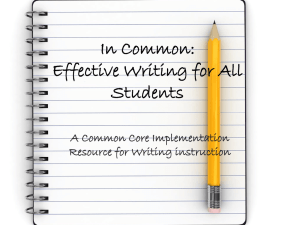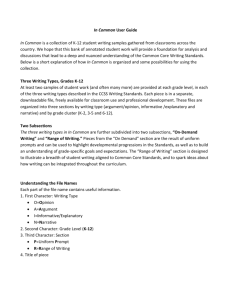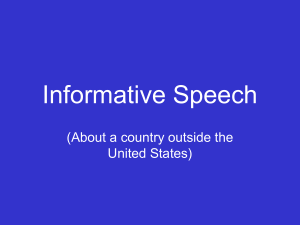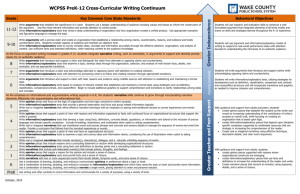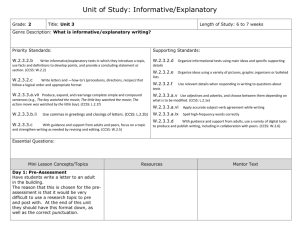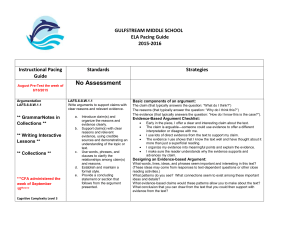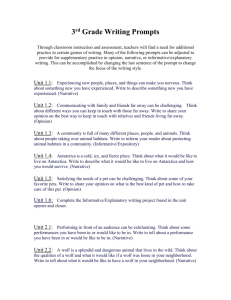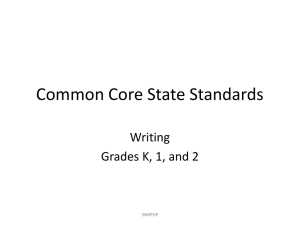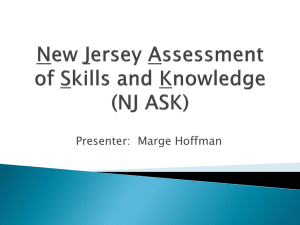File - Common Core History and Social Studies
advertisement
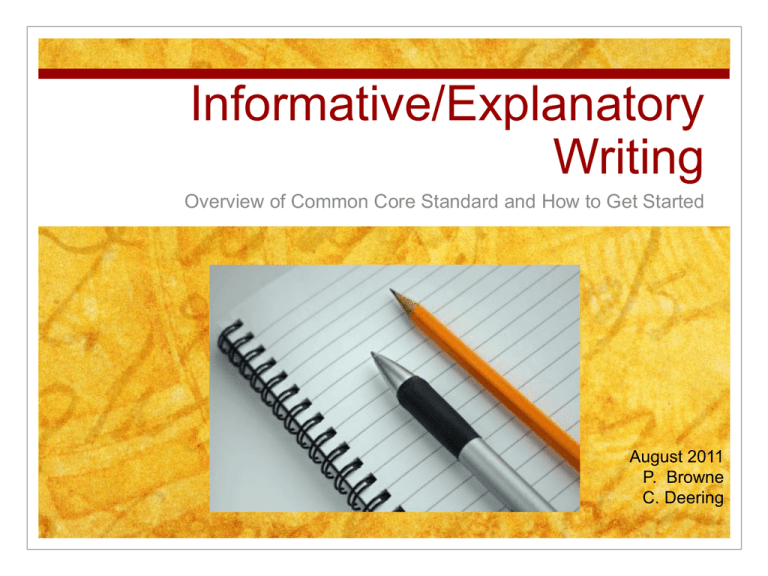
Informative/Explanatory Writing Overview of Common Core Standard and How to Get Started August 2011 P. Browne C. Deering Informative/Explanatory Writing (1) What (2) List is it? some examples: (3) Explain what it is not. W2 CCR Anchor Standard Write informative/explanatory texts to examine and convey complex ideas and information clearly and accurately through the effective selection, organization, and analysis of content. Essential Skills for Informational Writing W2.a Introduce a topic; organize ideas, concepts, and information, using strategies such as definition, classification, comparison/contrast, and cause/effect; include formatting (e.g., headings), graphics (e.g., charts, tables), and multimedia when useful to aiding comprehension. W2.b: Develop the topic with relevant facts, definition, concrete details, quotations, or other information and examples. W2.c: Use appropriate transitions to clarify the relationships among ideas and concepts. W2.d: Use precise language and domain-specific vocabulary to inform about or explain the topic. W2.e: Establish and maintain a formal style. W2.a - Write informative/explanatory texts to examine a topic and convey ideas, concepts, and information through the selection, organization, and analysis of relevant content. W2.a - Grade 6: Introduce a topic; organize ideas, concepts, and information, using strategies such as definition, classification, comparison/contrast, and cause/effect; include formatting (e.g., headings), graphics (e.g., charts, tables), and multimedia when useful to aiding comprehension. W2.a - Grade 7: Introduce a topic clearly, previewing what is to follow; organize ideas, concepts, and information, using strategies such as definition, classification, comparison/contrast, and cause/effect; include formatting (e.g., headings), graphics (e.g., charts, tables), and multimedia when useful to aiding comprehension. W2.a - Grade 8: Introduce a topic clearly, previewing what is to follow; organize ideas, concepts, and information into broader categories; include formatting (e.g., headings) graphics (e.g., charts, tables) and multimedia when useful to aiding comprehension Reference Slides Slides 5 – 22, detail the essential skills for informative writing (W2 a – b) for each grade level These slides have been included in your packet for your reference and to enable you to complete the following informative writing activity. Writing Assignment! Analyze the Common Core for Informational Writing Skills and Knowledge (W2 A through E) for your grade level (pages 2 – 9 in the packet). Using the essential skills and knowledge specific to your grade level, respond to one of the following prompts: Explain to a non-educator what teachers need to accomplish to get ready for the first day of school (please refrain from whining!). Congratulations! You have just won a million dollars (after taxes)! Explain how you will spend it. Oh, by the way, you have only a week to do so. SLIDE 27 Getting Started: Instructional Process Instructional Snapshot Refer to the Informational / Explanatory Writing handout Basic Informational Writing Questions What? How? Why? Getting Started – Important Tasks for Students Identify and understand the topic – “Do I know exactly what the assignment is and what I am expected to do?” Develop a thesis - “Which statement can I craft that clearly expresses the central focus of my written response?” Select and analyze relevant content - “Which textual information would more effectively support my thesis?” Convey ideas clearly and precisely – “Can the reader follow my connections between the text and my thesis? Are my supporting points clear?” Determine the best organizational structure – “Which organizational structure would be the most effective for developing of my thesis? “ Examples of Organizational Structure Description Cause/ Effect Problem/ Solution Definition Classification Chronological Compare/Contrast When responding to an assignment, look for language in the assignment that might suggest or identify an organizational structure. Sample Prompts for Seminars Imagine that you had no TV, computer, or video games for one week. Think of some activities that you can do instead to keep you busy and out of trouble. Write an essay to explain what you can do to keep occupied in a week of no TV, computer, or video games. Think of some things you learned outside of school. For example, you learn from pet care, television, or grandparents. Explain what you learned. If you could visit anywhere on Earth, where would it be and why would you want to visit there? What things would you do there? Write a letter to the judges of a travel agency contest for a free vacation trip. Write the directions for "how to" do something. Your class is having a party. You want other students to come to it. Write a sign about the party. Your class is making a classroom cookbook. Write a recipe for something you like to eat at home to include in the book. Graphic Organizers for Informative/Explanatory Writing Graphic organizers provide a visual tool to enable students in putting their ideas together in an organized way through the writing process, to: choose a topic research a topic organize ideas create an outline to guide their writing. Some examples are included in the electronic resources. Select a graphic organizer that supports the organizational structure (e.g., Venn diagram for compare/contrast, etc.) Menu: Types of Informative Writing Assignments Basic paragraph Essay (definition, descriptive, cause/effect, problem/solution, etc.) Report Biography / autobiography Interview Advertisement or label (explaining a product or service) Diary entry, journal, log, blog Poster Interview Review/critique Website Documentary Menu Directions (recipe, lab procedures, technical instructions, directions for a game, rules for a sport, etc.) Term paper Brochure/pamphlet Article (newspaper, magazine, encyclopedia, etc.) Newscast Assessment – MHMS Rubric and Anchor Papers Rubrics for informative/explanatory writing were created by MHMS staff last spring; these rubrics were based on specific grade level demands of the Common Core curriculum (separate rubric for each grade level) Anchor papers also were developed: Grade 6 (science); Grade 7 (Science) and Grade 8 (Social Studies) Additional anchor papers may be found in the Common Core Appendix. An Effective Informative/Explanatory Writer: Understands the task and develops a clear and precise thesis which identifies the writer’s central purpose. Critically reads the text and makes thoughtful decisions when selecting textual evidence to support the thesis. Examines the effectiveness of connections between selected textual information and the thesis. Organizes the information in a structure that ensures the reader can effectively follow the writer’s development of ideas. An Effective Informative/Explanatory Writer (cont.): Provides a concluding statement or section that • follows from, and supports, the information or explanation presented. • does more than restate or summarize. Electronic Resources Writing Fix – Interactive Writing Prompts: http://writingfix.com/genres/informative.htm http://www2.asd.wednet.edu/pioneer/barnard/wri/exp.htm Purdue OWL - Crating a Thesis Statement: http://owl.english.purdue.edu/owl/resource/545/1/ Graphic Organizers for Informational Writing: http://worksheetplace.com/index.php?function=DisplayCategory&showCategory =Y&links=3&id=105&link1=43&link2=154&link3=105 http://www.greatsource.com/iwrite/students/s_expos.html HCPSS Transition to the Common Core wiki – http://transitiontocommoncore.hcpss.wikispaces.net/
